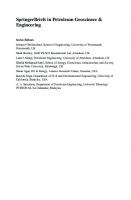Petroleum Geoscience [1 ed.] 0632037679, 9780632037674
It is a nice book, well written. But most of the examples are UK north sea stuff, very little north america examples. Th
264 108 726KB
English Pages 390 Year 2003
Table of contents :
Front Matter......Page 2
Preface......Page 4
Acknowledgments......Page 5
Index......Page 0
Table of Contents......Page 6
1.2 Background......Page 16
1.5.2 The Source......Page 17
1.5.4 The Trap......Page 18
1.5.13 The Gas to Oil Ratio......Page 19
1.5.16 The Units Used in This Book......Page 20
1.6.2 Naphthenes (Cycloalkenes)......Page 23
1.6.4 Asphaltenes......Page 24
1.7.2 Appraisal......Page 25
1.7.4 Production......Page 27
1.8 Geoscience Activity......Page 28
1.9 Oil, Gas, and Geoscientists - a Global Resource!......Page 30
Further Reading......Page 31
2.2.3 Gravimetric Data......Page 32
2.2.4 Magnetic Data......Page 34
2.3.1 Introduction......Page 35
2.3.2 The Seismic Method......Page 36
2.3.3 Seismic Acquisition......Page 37
2.3.5 Seismic Interpretation......Page 39
2.4.1 Introduction......Page 40
2.4.2 Rock Tools......Page 41
2.4.3 Porosity and Permeability Tools......Page 47
2.4.4 Fluid Tools......Page 49
2.4.5 Pressure Tool......Page 50
2.5.1 Introduction......Page 51
2.5.2 Conventional Core Analysis (Porosity and Permeability)......Page 53
2.5.3 Core Logging......Page 56
2.5.5 Geochemistry......Page 58
2.5.6 Biostratigraphy......Page 59
2.6.1 Introduction......Page 60
2.6.3 Petroleum......Page 61
2.6.4 Water......Page 62
2.7.2 Maps......Page 63
2.7.4 Rock Sampling and Analysis......Page 64
2.8 Seepage of Petroleum......Page 65
Further Reading......Page 67
3.1 Introduction......Page 68
3.2.1 Early Access to Acreage......Page 69
3.2.2 The Licensing Process......Page 70
3.2.3 License Areas......Page 71
3.3.2 Petroleum Leakage and Seepage......Page 72
3.3.3 The Identification of Petroleum on Seismic Data......Page 74
3.4.1 Introduction......Page 76
3.4.2 Extensional Basins, Generated by Divergent Plate Motion......Page 80
3.4.4 Strike-slip Basins......Page 84
3.5.1 Introduction......Page 86
3.5.2 Subsidence......Page 87
3.5.3 Sediment Supply......Page 90
3.5.5 Thermal History......Page 91
3.5.6 Uplift......Page 93
3.5.7 Pressure History......Page 94
3.6.1 Introduction......Page 95
3.6.3 Biostratigraphy......Page 96
3.6.5 Seismic Stratigraphy......Page 102
3.6.6 Sequence Stratigraphy......Page 104
3.6.8 Stratigraphic Tests......Page 109
3.7.2 The Origin of Petroleum from Living Organisms......Page 111
3.7.3 Kerogen......Page 112
3.7.4 Maturation of Source Rocks: Kerogen to Oil to Gas......Page 114
3.8.2 The Geologic Background......Page 116
3.8.5 Well Evaluation: 1990......Page 117
3.9.1 Introduction......Page 119
3.9.2 The Regional Geology and Basin Analysis......Page 120
3.9.3 Exploration History: 1983-5......Page 122
3.9.4 Exploration Success: 1985-7......Page 123
3.10.3 The Regional Geology and Basin Analysis......Page 125
3.10.4 Petroleum Geology......Page 129
3.10.6 Further Reading......Page 133
4.2.1 Introduction......Page 134
4.2.3 The Hydraulic Seal......Page 135
4.2.4 Faults......Page 136
4.2.5 Trap Fill......Page 137
4.2.6 The Pressure Seal......Page 138
4.3.1 Introduction......Page 139
4.3.2 Intrinsic Properties......Page 140
4.3.3 Reservoir Lithologies......Page 144
4.3.4 The Reservoir: Sandstone Depositional Systems......Page 145
4.3.5 The Reservoir: Limestone and Dolomite......Page 153
4.3.6 Fractured Reservoirs......Page 157
4.4.2 Primary Migration......Page 159
4.4.3 Secondary Migration......Page 162
4.4.4 Tertiary Migration......Page 166
4.5.1 Introduction......Page 168
4.5.3 Structural Traps......Page 171
4.5.4 Stratigraphic Traps......Page 183
4.5.5 Hydrodynamic Traps......Page 189
4.6.1 Play......Page 190
4.6.2 Play Fairway......Page 191
4.7.1 Introduction......Page 193
4.7.2 Lead, Prospect, and Prospect Evaluation......Page 194
4.7.4 Well Prognosis......Page 196
4.8.1 Introduction......Page 197
4.8.3 Pool Size Distribution......Page 198
4.8.4 Creaming Curves and Destruction of Value......Page 200
4.9.2 Risk......Page 202
4.9.3 Uncertainty......Page 203
4.10.1 Introduction......Page 204
4.10.3 The Petroleum Charge System......Page 205
4.10.4 The Distribution of the Top Seal......Page 208
4.10.5 Drilling Statistics and Common Risk Segments......Page 209
4.10.6 Conclusions......Page 211
5.1 Introduction......Page 212
5.2.1 Depth Conversion......Page 213
5.2.2 Mapping Surfaces and Faults......Page 214
5.2.3 Spill Points......Page 219
5.3.1 Fluid Contacts and Transition Zones......Page 221
5.3.2 Intra-field Variations in Petroleum Composition......Page 223
5.3.3 Intra-field Variations in Water Composition......Page 228
5.4.2 Barriers to Lateral Flow......Page 229
5.4.4 Identification of Flow Barriers......Page 231
5.5.1 Introduction......Page 232
5.5.2 Lithofacies and Lithotypes......Page 233
5.5.3 Reservoir Body Geometry......Page 234
5.5.4 Reservoir Correlation......Page 236
5.9.3 The Geologic Setting......Page 238
5.9.4 Spiculite Petrography and Reservoir Quality......Page 239
5.9.5 Oil in Place......Page 240
5.9.6 Conclusions......Page 243
5.10.2 The License Background......Page 244
5.10.3 Appraisal Phase: 1997-8......Page 247
5.11.1 Introduction......Page 249
5.11.2 The Database......Page 250
5.11.4 The Geology of the Sarvestan and Saadat Abad Fields......Page 252
5.11.5 Field Studies: Sarvestan Fault Zone......Page 253
5.11.7 Fractures......Page 254
5.11.8 Core Examination......Page 255
Further Reading......Page 256
6.2.1 Facilities Location and Well Numbers......Page 257
6.2.2 Well Geometries......Page 260
6.2.3 Well Types......Page 263
6.2.5 Well Completion and Stimulation......Page 264
6.2.6 Formation Damage......Page 266
6.2.7 Well Logging and Testing......Page 268
6.3.1 Reservoir Description from Production Data......Page 272
6.3.2 Reservoir Visualization......Page 273
6.3.3 Time-lapse Seismic......Page 275
6.3.4 Managing Decline and Abandonment......Page 277
6.4.3 Reserves Additions......Page 279
6.4.4 Field Rehabilitation and Reactivation......Page 280
6.5.2 Offshore Development: the Environmental Issue......Page 282
6.5.3 Geologic Constraints on Stage III Development......Page 283
6.5.4 Hitting the Target......Page 284
6.5.5 Delivering the Productivity......Page 285
6.6.1 Introduction......Page 288
6.6.2 The Geologic Background......Page 289
6.6.3 Cement Mineralogy and Timing of Diagenesis......Page 290
6.6.4 The Source of the Cements......Page 291
6.6.5 The Distribution of the Cements......Page 292
6.6.6 Conclusions......Page 293
6.7.3 An Initial Description of the Structure and Reservoir Architecture......Page 294
6.7.4 The History of Field Development......Page 296
6.7.5 Conclusions......Page 301
6.8.2 The Geologic Background......Page 302
6.8.4 Conclusions......Page 304
6.9.1 Introduction......Page 305
6.9.2 The Field History......Page 307
6.9.3 Oil in Place and Reserves......Page 312
6.9.4 Can the Crawford Field Be Reactivated?......Page 314
6.10.2 Remaining Oil Potential: Southern Trinidad......Page 316
6.10.3 Rehabilitation: Palo Seco Field, Trinidad......Page 318
6.10.4 The History of the Palo Seco Field......Page 319
6.10.7 Opportunities for Improved Recovery and Production Rate......Page 320
6.10.9 Commercial Evaluation......Page 322
6.10.10 Conclusions......Page 323
Further Reading......Page 324
A......Page 325
B......Page 327
C......Page 330
D......Page 334
E......Page 335
F......Page 336
G......Page 340
H......Page 343
I......Page 344
K......Page 345
L......Page 346
M......Page 347
N......Page 349
O......Page 350
P......Page 357
R......Page 362
S......Page 365
T......Page 371
V......Page 374
W......Page 375
Z......Page 377
References......Page 378
Front Matter......Page 2
Preface......Page 4
Acknowledgments......Page 5
Index......Page 0
Table of Contents......Page 6
1.2 Background......Page 16
1.5.2 The Source......Page 17
1.5.4 The Trap......Page 18
1.5.13 The Gas to Oil Ratio......Page 19
1.5.16 The Units Used in This Book......Page 20
1.6.2 Naphthenes (Cycloalkenes)......Page 23
1.6.4 Asphaltenes......Page 24
1.7.2 Appraisal......Page 25
1.7.4 Production......Page 27
1.8 Geoscience Activity......Page 28
1.9 Oil, Gas, and Geoscientists - a Global Resource!......Page 30
Further Reading......Page 31
2.2.3 Gravimetric Data......Page 32
2.2.4 Magnetic Data......Page 34
2.3.1 Introduction......Page 35
2.3.2 The Seismic Method......Page 36
2.3.3 Seismic Acquisition......Page 37
2.3.5 Seismic Interpretation......Page 39
2.4.1 Introduction......Page 40
2.4.2 Rock Tools......Page 41
2.4.3 Porosity and Permeability Tools......Page 47
2.4.4 Fluid Tools......Page 49
2.4.5 Pressure Tool......Page 50
2.5.1 Introduction......Page 51
2.5.2 Conventional Core Analysis (Porosity and Permeability)......Page 53
2.5.3 Core Logging......Page 56
2.5.5 Geochemistry......Page 58
2.5.6 Biostratigraphy......Page 59
2.6.1 Introduction......Page 60
2.6.3 Petroleum......Page 61
2.6.4 Water......Page 62
2.7.2 Maps......Page 63
2.7.4 Rock Sampling and Analysis......Page 64
2.8 Seepage of Petroleum......Page 65
Further Reading......Page 67
3.1 Introduction......Page 68
3.2.1 Early Access to Acreage......Page 69
3.2.2 The Licensing Process......Page 70
3.2.3 License Areas......Page 71
3.3.2 Petroleum Leakage and Seepage......Page 72
3.3.3 The Identification of Petroleum on Seismic Data......Page 74
3.4.1 Introduction......Page 76
3.4.2 Extensional Basins, Generated by Divergent Plate Motion......Page 80
3.4.4 Strike-slip Basins......Page 84
3.5.1 Introduction......Page 86
3.5.2 Subsidence......Page 87
3.5.3 Sediment Supply......Page 90
3.5.5 Thermal History......Page 91
3.5.6 Uplift......Page 93
3.5.7 Pressure History......Page 94
3.6.1 Introduction......Page 95
3.6.3 Biostratigraphy......Page 96
3.6.5 Seismic Stratigraphy......Page 102
3.6.6 Sequence Stratigraphy......Page 104
3.6.8 Stratigraphic Tests......Page 109
3.7.2 The Origin of Petroleum from Living Organisms......Page 111
3.7.3 Kerogen......Page 112
3.7.4 Maturation of Source Rocks: Kerogen to Oil to Gas......Page 114
3.8.2 The Geologic Background......Page 116
3.8.5 Well Evaluation: 1990......Page 117
3.9.1 Introduction......Page 119
3.9.2 The Regional Geology and Basin Analysis......Page 120
3.9.3 Exploration History: 1983-5......Page 122
3.9.4 Exploration Success: 1985-7......Page 123
3.10.3 The Regional Geology and Basin Analysis......Page 125
3.10.4 Petroleum Geology......Page 129
3.10.6 Further Reading......Page 133
4.2.1 Introduction......Page 134
4.2.3 The Hydraulic Seal......Page 135
4.2.4 Faults......Page 136
4.2.5 Trap Fill......Page 137
4.2.6 The Pressure Seal......Page 138
4.3.1 Introduction......Page 139
4.3.2 Intrinsic Properties......Page 140
4.3.3 Reservoir Lithologies......Page 144
4.3.4 The Reservoir: Sandstone Depositional Systems......Page 145
4.3.5 The Reservoir: Limestone and Dolomite......Page 153
4.3.6 Fractured Reservoirs......Page 157
4.4.2 Primary Migration......Page 159
4.4.3 Secondary Migration......Page 162
4.4.4 Tertiary Migration......Page 166
4.5.1 Introduction......Page 168
4.5.3 Structural Traps......Page 171
4.5.4 Stratigraphic Traps......Page 183
4.5.5 Hydrodynamic Traps......Page 189
4.6.1 Play......Page 190
4.6.2 Play Fairway......Page 191
4.7.1 Introduction......Page 193
4.7.2 Lead, Prospect, and Prospect Evaluation......Page 194
4.7.4 Well Prognosis......Page 196
4.8.1 Introduction......Page 197
4.8.3 Pool Size Distribution......Page 198
4.8.4 Creaming Curves and Destruction of Value......Page 200
4.9.2 Risk......Page 202
4.9.3 Uncertainty......Page 203
4.10.1 Introduction......Page 204
4.10.3 The Petroleum Charge System......Page 205
4.10.4 The Distribution of the Top Seal......Page 208
4.10.5 Drilling Statistics and Common Risk Segments......Page 209
4.10.6 Conclusions......Page 211
5.1 Introduction......Page 212
5.2.1 Depth Conversion......Page 213
5.2.2 Mapping Surfaces and Faults......Page 214
5.2.3 Spill Points......Page 219
5.3.1 Fluid Contacts and Transition Zones......Page 221
5.3.2 Intra-field Variations in Petroleum Composition......Page 223
5.3.3 Intra-field Variations in Water Composition......Page 228
5.4.2 Barriers to Lateral Flow......Page 229
5.4.4 Identification of Flow Barriers......Page 231
5.5.1 Introduction......Page 232
5.5.2 Lithofacies and Lithotypes......Page 233
5.5.3 Reservoir Body Geometry......Page 234
5.5.4 Reservoir Correlation......Page 236
5.9.3 The Geologic Setting......Page 238
5.9.4 Spiculite Petrography and Reservoir Quality......Page 239
5.9.5 Oil in Place......Page 240
5.9.6 Conclusions......Page 243
5.10.2 The License Background......Page 244
5.10.3 Appraisal Phase: 1997-8......Page 247
5.11.1 Introduction......Page 249
5.11.2 The Database......Page 250
5.11.4 The Geology of the Sarvestan and Saadat Abad Fields......Page 252
5.11.5 Field Studies: Sarvestan Fault Zone......Page 253
5.11.7 Fractures......Page 254
5.11.8 Core Examination......Page 255
Further Reading......Page 256
6.2.1 Facilities Location and Well Numbers......Page 257
6.2.2 Well Geometries......Page 260
6.2.3 Well Types......Page 263
6.2.5 Well Completion and Stimulation......Page 264
6.2.6 Formation Damage......Page 266
6.2.7 Well Logging and Testing......Page 268
6.3.1 Reservoir Description from Production Data......Page 272
6.3.2 Reservoir Visualization......Page 273
6.3.3 Time-lapse Seismic......Page 275
6.3.4 Managing Decline and Abandonment......Page 277
6.4.3 Reserves Additions......Page 279
6.4.4 Field Rehabilitation and Reactivation......Page 280
6.5.2 Offshore Development: the Environmental Issue......Page 282
6.5.3 Geologic Constraints on Stage III Development......Page 283
6.5.4 Hitting the Target......Page 284
6.5.5 Delivering the Productivity......Page 285
6.6.1 Introduction......Page 288
6.6.2 The Geologic Background......Page 289
6.6.3 Cement Mineralogy and Timing of Diagenesis......Page 290
6.6.4 The Source of the Cements......Page 291
6.6.5 The Distribution of the Cements......Page 292
6.6.6 Conclusions......Page 293
6.7.3 An Initial Description of the Structure and Reservoir Architecture......Page 294
6.7.4 The History of Field Development......Page 296
6.7.5 Conclusions......Page 301
6.8.2 The Geologic Background......Page 302
6.8.4 Conclusions......Page 304
6.9.1 Introduction......Page 305
6.9.2 The Field History......Page 307
6.9.3 Oil in Place and Reserves......Page 312
6.9.4 Can the Crawford Field Be Reactivated?......Page 314
6.10.2 Remaining Oil Potential: Southern Trinidad......Page 316
6.10.3 Rehabilitation: Palo Seco Field, Trinidad......Page 318
6.10.4 The History of the Palo Seco Field......Page 319
6.10.7 Opportunities for Improved Recovery and Production Rate......Page 320
6.10.9 Commercial Evaluation......Page 322
6.10.10 Conclusions......Page 323
Further Reading......Page 324
A......Page 325
B......Page 327
C......Page 330
D......Page 334
E......Page 335
F......Page 336
G......Page 340
H......Page 343
I......Page 344
K......Page 345
L......Page 346
M......Page 347
N......Page 349
O......Page 350
P......Page 357
R......Page 362
S......Page 365
T......Page 371
V......Page 374
W......Page 375
Z......Page 377
References......Page 378
![Petroleum Geoscience [1 ed.]
0632037679, 9780632037674](https://ebin.pub/img/200x200/petroleum-geoscience-1nbsped-0632037679-9780632037674.jpg)
![Petroleum Geoscience [1 ed.]
9780632037674, 0632037679](https://ebin.pub/img/200x200/petroleum-geoscience-1nbsped-9780632037674-0632037679.jpg)


![Advanced Methods in Petroleum Geochemistry (SpringerBriefs in Petroleum Geoscience & Engineering) [1st ed. 2024]
3031444043, 9783031444043](https://ebin.pub/img/200x200/advanced-methods-in-petroleum-geochemistry-springerbriefs-in-petroleum-geoscience-amp-engineering-1st-ed-2024-3031444043-9783031444043.jpg)
![Petroleum Geoscience: Second Edition [2 ed.]
2020025465, 2020025466, 9781405199605, 9781119232339, 9781119232346](https://ebin.pub/img/200x200/petroleum-geoscience-second-edition-2nbsped-2020025465-2020025466-9781405199605-9781119232339-9781119232346.jpg)




